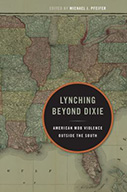Lynching Beyond Dixie: American Mob Violence Outside the South

Editor: Michael J. Pfeifer
Publisher: Urbana, IL: University of Illinois Press, 2013. 336p.
Reviewer: Manfred Berg | January 2014
According to the most conservative estimates, nearly 5,000 persons were lynched in the United States between the 1880s and the aftermath of World War II. More than 80 percent of those lynchings occurred in the South and more than 80 percent of all Southern lynch victims were African-Americans. Not surprisingly, historians interested in the history of lynching in America have long focused on racist mob violence in the Jim Crow South, producing an abundance of local and regional case studies. However, in recent years lynching scholars have considerably broadened the scope of their work and paid more attention to other regions of the United States as well as to nonblack victims. Studies on Western “frontier justice” found that per capita lynching rates in several Western states and territories were on a par with the Deep South, while other research demonstrated that Northern mobs targeted African-Americans for the same reasons as Southern lynchers, albeit much less frequently. Yet, although there are a growing number of case studies that focus on lynching outside the South, there is no monograph or edited volume that provides a detailed and comprehensive picture of lynching and mob violence in the rest of the United States.
Lynching Beyond Dixie is therefore a welcome contribution to the study of mob violence in American history. The book is organized geographically and includes ten case studies from the West, the Midwest, and the Northeast, covering a chronological span from the late 18th to the early 20th centuries. The appendix offers a useful state-by-state inventory of recorded lynchings outside the South that provides information on the time and place of known incidents, the name and race of the victims, as well as on the alleged offense and the method of execution. Perhaps the editor could have taken the trouble to summarize some of the data for the convenience of the reader by giving, for example, the total number of incidents and the distribution by race and region.
In his introduction, Michael Pfeifer, a leading scholar in the field, argues that the view of lynching as a peculiar Southern phenomenon rooted in the history of slavery and racism is misleading; and, that the practice should be understood as a long contest between the advocates of popular justice meted out by local communities and reformers trying to impose a state monopoly of criminal justice predicated on the rule of law. As Pfeifer has demonstrated in his book Rough Justice (2004), that contest lasted for more than a century and encompassed the entire United States. Accordingly, the goal of Lynching Beyond Dixie is to contribute “to a more comprehensive history of American lynching…by shifting the focus…beyond the South, while still keeping Dixie in mind. The intention here is to illuminate the similarities and differences between lynching in the West, the Midwest, and the Mid-Atlantic, and that which occurred in the South” (3).Then again, as the editor himself notes, this dichotomy between the South and the non-South primarily reflects the “origins of lynching scholarship in the work of antilynching activists” (2) during the first half of the 20th century who, understandably, tried to shame the South by stressing its “negative exceptionalism.” However, as recent studies suggest, the culture of violence in the West, including lynching, homicide, and interpersonal violence in general, had much more in common with the South than with the Northeast, which for that matter, never differed much from Western Europe in its levels of violence. Hence, Pfeifer concludes that “the few lynchings that occurred north of the Chesapeake are interesting as exceptions that prove the rule” (11). Dena Lynn Winslow’s short essay treats the only confirmed lynching in New England, which occurred in Northern Maine in 1873, largely as a curiosity and as the subject of local folklore.
As it is the case with all edited collections, the quality and persuasiveness of individual contributions vary. Christopher Waldrep offers a convincing analysis of the 1856 Vigilance Committee in San Francisco as an exercise in “pure politics” (55) that challenged constitutionalism in the name of popular sovereignty. According to Waldrep, American toleration for Southern lynching in later years was not only based on racism, but also on shared ideas about the right of the people “to form crowds and control crime outside the law” (74). Brent Campney effectively contests the notion of post-Civil War Kansas as a racially liberal state and interprets antiblack violence as part of a larger strategy to secure the West for whites. William Carrigan and Clive Webb, who deserve praise for their groundbreaking research on mob violence against Mexicans, argue that the quest for statehood and the fear of diplomatic reprisals by Mexico were key factors in ending lynch law in Arizona. In his account of the race riots in Springfield, Ohio, Jack Blocker looks at urban spaces of interracial contact and mingling as hot spots of lynching and racial violence.
Other essays raise serious conceptual concerns, however. In her paper on Lynching, Gender, and Culture in the Nineteenth-Century West, Helen McLure insists that anti-Indian massacres must be classified as lynchings because they meet the criteria of the famous definition agreed upon by antilynching groups in 1940, according to which “there must be legal evidence that a person has been killed, and that he met his death illegally at the hands of a group acting under the pretext of service to justice, race, or tradition” (25). The author may have a point that many of these massacres were triggered by Euro-Americans claiming to punish alleged Indian crimes. Still, the language of extermination she employs in this context suggests violence of a different character and magnitude than is usually associated with lynching as extralegal communal punishment. Moreover, the author’s effort to link radical settler racism and anti-Indian massacres to the lynching of Mexican, Chinese, and Anglo women does not make a coherent story in my view. Finally, McLure argues that lynchers and their apologists successfully demonized women who were lynched, but then concludes that the lynching of white women provoked “shock, horror, and condemnation” (44). Readers might expect some explanation here just as the author should have substantiated her repeated claim that “many more of these cases [the lynching of women and children] occurred than has previously been understood” (21), but “have long been discarded from historical memory “(44).
In his essay on African American Responses to Lynching in Decatur, Illinois, Sundiata Keita Cha-Jua mounts a harsh critique of historical scholarship for failing to recognize the extent and militancy of black resistance against lynching. According to the author, historians have treated African-Americans as passive victims by ignoring resistance altogether, resurrected the racist stereotype of the “Old Negro” by focusing on non-confrontational modes of resisting, and privileged traditional “reform tactics” by emphasizing “legalism and institutional politics.” As a consequence, Cha-Jua writes, blacks figure mostly as “props, objects, or victims devoid of agency” (168-169). However, after reading the author’s account of the 1893 lynching of Samuel J. Bush in Decatur and the ensuing protest by the local black community it triggered, I could not really see how Cha-Jua’s differs from other narratives, other than by employing jargon-ridden language (“density, multiplicity, systematicity”) to explicate rather obvious facts. It seems to me that the author somewhat unfairly criticizes other scholars in order to boost his own claim to originality.
Lynching Beyond Dixie is a must-read for all historians who work on lynching and mob violence in American history. The book brings together interesting case studies, new empirical evidence, and challenging perspectives. Most importantly, it clearly demonstrates that “Southern exceptionalism” in the study of lynching is no longer tenable.
Manfred Berg, Curt Engelhorn Professor of American History, Heidelberg University, Germany


